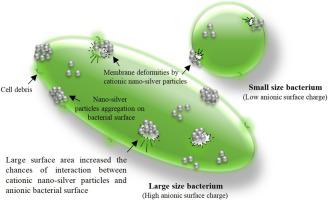当前位置:
X-MOL 学术
›
J. Trace Elem. Med. Bio.
›
论文详情
Our official English website, www.x-mol.net, welcomes your
feedback! (Note: you will need to create a separate account there.)
The impact of bacterial size on their survival in the presence of cationic particles of nano-silver.
Journal of Trace Elements in Medicine and Biology ( IF 3.6 ) Pub Date : 2020-05-18 , DOI: 10.1016/j.jtemb.2020.126517 Samir A Anuj 1 , Harsukh P Gajera 2 , Darshna G Hirpara 2 , Baljibhai A Golakiya 2
Journal of Trace Elements in Medicine and Biology ( IF 3.6 ) Pub Date : 2020-05-18 , DOI: 10.1016/j.jtemb.2020.126517 Samir A Anuj 1 , Harsukh P Gajera 2 , Darshna G Hirpara 2 , Baljibhai A Golakiya 2
Affiliation

|
BACKGROUND
Microbial surface area is one of the battlegrounds for invading microbes and host defense. Hence, infectious diseases caused by drug resistant microbes with large surface area are more difficult to treat than small size microbes. Nanobiology offers opportunities to re-explore the biological properties of conventional drugs at molecular level to combat these microbes. The purpose of the present study was to examine size depended susceptibility of Gram-positive bacteria towards nano-silver particles.
METHODS
This study investigated the growth, surface charge, and morphology of emerging B. megaterium MTCC 7192 and re-emerging S. aureus MTCC 3160 cells in order to observe the susceptibility of these bacteria towards cationic nano-silver particles. Nano-silver particles were applied into wells formed on the Nutrient agar plates containing 108 CFU/mL of the bacteria. Surface potential of normal and treated cells was measured by Microtrac and the effects of nano-silver particles on bacterial cells were assessed by Scanning Electron Microscopy (SEM).
RESULTS
In this work, synthesized nano-silver particles were found to be more effective against B. megaterium MTCC 7192 than S. aureus MTCC 3160. For B. megaterium MTCC 7192, a 0.30 fold increase in inhibition zone was observed after the addition of nano-silver particles in the wells. From our studies, it is reasonable to state that alternation of zeta potential may affect the cell morphology, which was further confirmed by SEM.
CONCLUSION
The present study concluded that nano-silver particles appears to interact with a larger surface area more effectively.
中文翻译:

在纳米银阳离子颗粒存在的情况下,细菌大小对其生存的影响。
背景技术微生物表面积是微生物入侵和宿主防御的战场之一。因此,由大表面积的耐药微生物引起的传染病比小尺寸的微生物更难治疗。纳米生物学提供了在分子水平上重新探索传统药物的生物学特性以对抗这些微生物的机会。本研究的目的是检查革兰氏阳性细菌对纳米银颗粒的尺寸依赖性敏感性。方法本研究调查了新出现的巨大芽孢杆菌 MTCC 7192 和重新出现的金黄色葡萄球菌 MTCC 3160 细胞的生长、表面电荷和形态,以观察这些细菌对阳离子纳米银颗粒的敏感性。将纳米银颗粒应用到含有 108 CFU/mL 细菌的营养琼脂板上形成的孔中。通过 Microtrac 测量正常细胞和处理细胞的表面电位,并通过扫描电子显微镜 (SEM) 评估纳米银颗粒对细菌细胞的影响。结果在这项工作中,发现合成的纳米银颗粒对巨大芽孢杆菌 MTCC 7192 比金黄色葡萄球菌 MTCC 3160 更有效。对于巨大芽孢杆菌 MTCC 7192,添加纳米银颗粒后观察到抑制区增加了 0.30 倍。 -孔中的银颗粒。根据我们的研究,有理由认为 zeta 电位的变化可能会影响细胞形态,并且 SEM 进一步证实了这一点。结论 本研究得出的结论是,纳米银颗粒似乎可以更有效地与更大的表面积相互作用。
更新日期:2020-05-18
中文翻译:

在纳米银阳离子颗粒存在的情况下,细菌大小对其生存的影响。
背景技术微生物表面积是微生物入侵和宿主防御的战场之一。因此,由大表面积的耐药微生物引起的传染病比小尺寸的微生物更难治疗。纳米生物学提供了在分子水平上重新探索传统药物的生物学特性以对抗这些微生物的机会。本研究的目的是检查革兰氏阳性细菌对纳米银颗粒的尺寸依赖性敏感性。方法本研究调查了新出现的巨大芽孢杆菌 MTCC 7192 和重新出现的金黄色葡萄球菌 MTCC 3160 细胞的生长、表面电荷和形态,以观察这些细菌对阳离子纳米银颗粒的敏感性。将纳米银颗粒应用到含有 108 CFU/mL 细菌的营养琼脂板上形成的孔中。通过 Microtrac 测量正常细胞和处理细胞的表面电位,并通过扫描电子显微镜 (SEM) 评估纳米银颗粒对细菌细胞的影响。结果在这项工作中,发现合成的纳米银颗粒对巨大芽孢杆菌 MTCC 7192 比金黄色葡萄球菌 MTCC 3160 更有效。对于巨大芽孢杆菌 MTCC 7192,添加纳米银颗粒后观察到抑制区增加了 0.30 倍。 -孔中的银颗粒。根据我们的研究,有理由认为 zeta 电位的变化可能会影响细胞形态,并且 SEM 进一步证实了这一点。结论 本研究得出的结论是,纳米银颗粒似乎可以更有效地与更大的表面积相互作用。











































 京公网安备 11010802027423号
京公网安备 11010802027423号